La velocidad es el motor del surf; es lo que te permite hacer movimientos geniales, atrapar más olas y simplemente divertirte en el agua. Pero si recién estás empezando, aprender a surfear es una buena idea. ¿Qué tan rápido puedes ir en una tabla de surf? Puede parecer difícil. La velocidad a la que puede llegar un surfista depende en gran medida de varios factores, entre ellos el tamaño y la forma de la ola, el diseño de la tabla de surf y la habilidad del propio surfista. Por lo general, los surfistas pueden alcanzar velocidades de hasta 30 o 48 kilómetros por hora en una buena ola. Aprender a aprovechar la potencia de la ola de forma eficaz puede aumentar drásticamente su velocidad.
Ahí es donde entra en juego esta guía. Hemos reunido consejos y trucos fáciles de seguir que cualquiera puede conocer. Cómo generar velocidad al surfear . Ya sea que seas principiante o que solo busques ser un poco más rápido, estas sencillas estrategias te ayudarán a atravesar las olas en poco tiempo.
Técnicas básicas para generar velocidad en el surf
Aprender a generar velocidad en el surf no tiene por qué ser una tarea abrumadora. Los principios básicos son sencillos y se aplican tanto si eres un principiante que navega por la cara de la ola como si eres un surfista avanzado que intenta realizar maniobras como los saltos. Es más sencillo de lo que parece.
1. Usando la cara de onda
Cuando hablamos de usar la cara de la ola, aprovechamos al máximo toda la superficie de la ola. Los principiantes apuntan a la parte superior de la ola. Desde allí, inclina la tabla hacia abajo: ese es el secreto. Cómo generar velocidad al surfear . Para quienes llevan un tiempo surfeando, se trata de encontrar el ritmo entre los tercios superior e inferior de la ola. Es esta combinación de técnica y sensación lo que convierte una buena ola en una excelente.
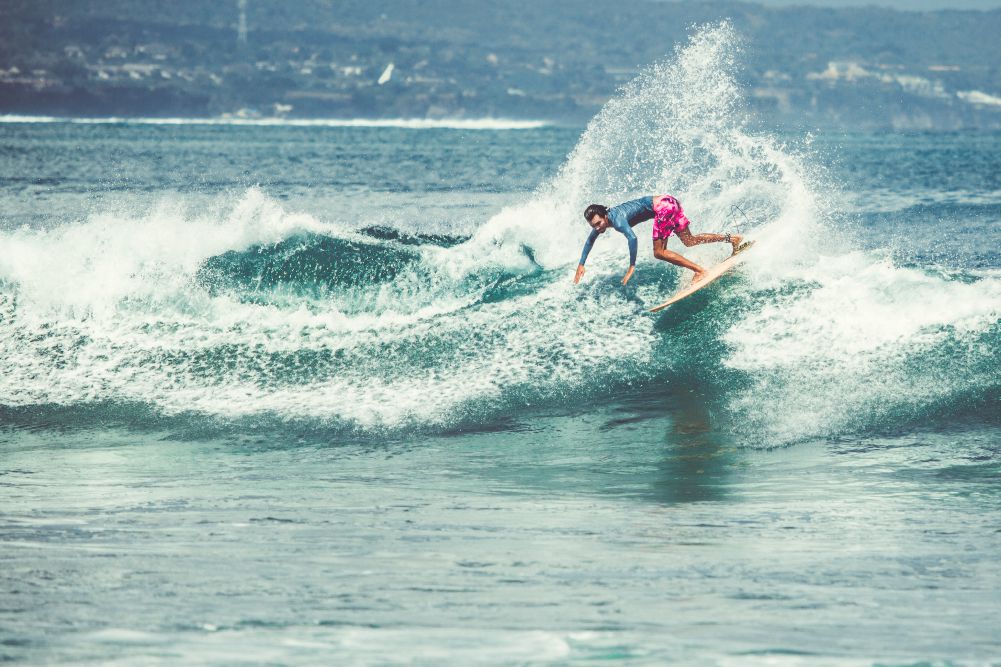
2. Usando las piernas
En el surf, las piernas son las que impulsan y dirigen la tabla. Una de las formas de Cómo conseguir velocidad de surf El objetivo es concentrarse en comprimir y extender las piernas. Cuanto más te inclines, más empuje le darás a tu tabla de surf, lo que te hará ir más rápido. Solo asegúrate de que tu tabla esté inclinada (sobre su riel) mientras haces esto. Doblar las piernas e inclinarte al mismo tiempo puede, de hecho, aumentar la velocidad.
3. Usando los brazos
Un error común en el aprendizaje Cómo generar velocidad de surf No está utilizando los brazos de forma eficaz. Muchos surfistas utilizan los brazos solo para mantener el equilibrio, pero en realidad pueden ayudarle a ir más rápido. Trate de no perder de vista la mano que lleva detrás. Cambiar la forma en que utiliza los brazos puede ayudarle a ganar velocidad al surfear.
¿Cómo ganar velocidad surfeando con técnicas avanzadas?
Profundicemos en técnicas avanzadas para ir más allá de lo básico y realmente sobresalir en el speed surfing.
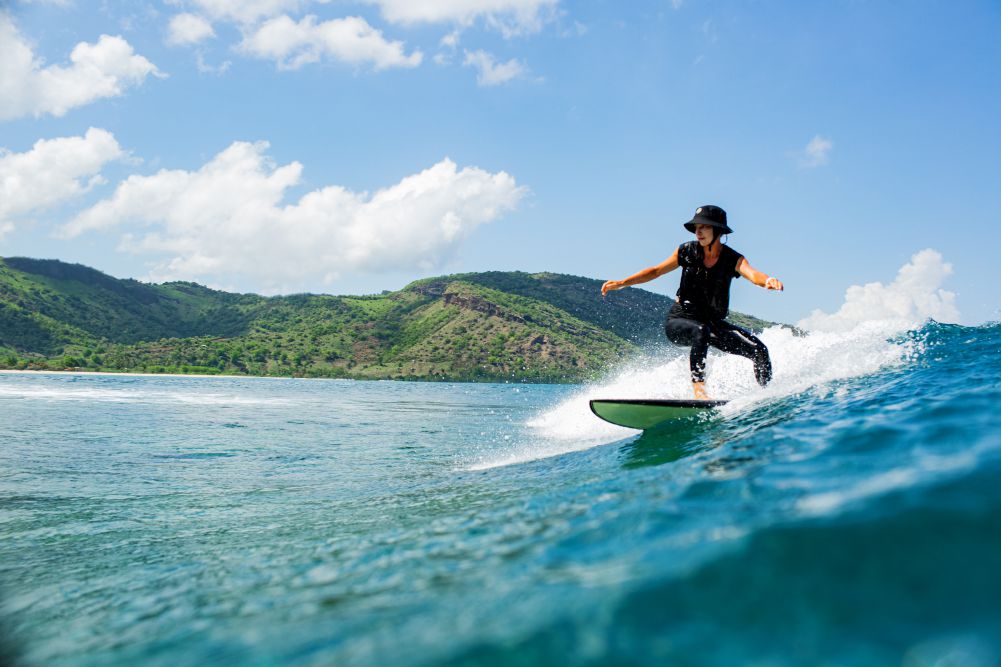
1. Elige la tabla adecuada
La elección de la tabla de surf puede afectar significativamente la velocidad y la maniobrabilidad en las olas. Debes elegir una tabla que se adapte a tu nivel de habilidad, tu tipo de cuerpo y las condiciones predominantes de las olas.
- Las tablas más cortas se destacan por su maniobrabilidad y capacidad de respuesta, aunque pueden representar desafíos para remar y atrapar olas.
- Las tablas más largas simplifican la remada y la captura de olas, pero pueden comprometer la agilidad y la generación de velocidad.
- Las tablas más anchas brindan estabilidad y flotabilidad, aunque a costa de una mayor resistencia al agua y fricción.
- Las tablas más estrechas priorizan la agilidad y la capacidad de respuesta, sacrificando potencialmente algo de estabilidad y flotabilidad.
- Las tablas más gruesas proporcionan mayor flotabilidad y tolerancia, pero pueden sacrificar la precisión en sus maniobras.
- Las tablas más delgadas son conocidas por su precisión y sensibilidad, pero pueden comprometer la flotación y la tolerancia.
Es evidente que existe un equilibrio entre velocidad y estabilidad, así como entre facilidad de uso y alto rendimiento. Encontrar el equilibrio adecuado para tus objetivos requiere experimentar con diferentes tablas para comprender cómo afectan tu velocidad y tu estilo de surf.
2. Remar con eficiencia
Remar influye directamente en la rapidez con la que puedes atrapar olas y en cuántas olas puedes surfear. Remar de manera eficiente implica utilizar la técnica, el ritmo y la fuerza adecuados para maximizar tu velocidad y resistencia mientras estás en el agua. A continuación, te ofrecemos algunos consejos valiosos para mejorar tu eficiencia al remar:
- Mantén el cuerpo recto sobre la tabla, alineando la cabeza, los hombros, las caderas y los pies. Esto minimiza la resistencia y garantiza un mejor equilibrio.
- Mantén la cabeza erguida y concéntrate en mirar hacia delante en lugar de hacia abajo, a tu tabla, mejorando así la conciencia de las olas y la evitación de obstáculos, además de mejorar la postura y la respiración.
- Mantenga los brazos cerca del cuerpo, logrando un equilibrio entre ancho y estrechez, lo que crea más potencia y apalancamiento al tiempo que reduce la fatiga y el riesgo de lesiones.
- Mantenga la mano en posición ahuecada con los dedos juntos, evitando que quede plana o extendida. Las manos ahuecadas generan más elevación y propulsión, al tiempo que reducen la resistencia.
3. Atrapa la ola temprano
Para aumentar tu velocidad de surf, atrapar olas temprano te permite ubicarte en la ola antes de que rompa o cuando comienza a romper, lo que te da una ventaja y más tiempo para ganar velocidad.
- Elegir la mejor ola: Elige una ola que se adapte a tu nivel de surf y al tipo de tabla que tengas. Evita las olas que sean demasiado grandes o pequeñas, demasiado empinadas o planas, demasiado rápidas o lentas, y que estén demasiado llenas o vacías.
- Llegar al lugar correcto: Para surfear a buena velocidad, quédate cerca de la parte superior de la ola, donde empieza a romper y es más empinada. Coloca tu tabla en un ligero ángulo con respecto a la ola, no de frente ni a lo largo de ella.
- Remando hacia la derecha: Cuando se acerca una ola, rema con la fuerza suficiente para igualar su velocidad. No remes demasiado fuerte o podrías perder el control. Tu remada debe ir al ritmo de la ola, lo que te ayudará a generar velocidad al surfear, en lugar de luchar contra ella o tratar de remar más rápido que ella.
Cuando coges la ola antes, tienes la oportunidad de empezar en una parte más empinada de la ola, lo que te ayuda a ir más rápido gracias a la gravedad. La gravedad te empuja a ti y a tu tabla hacia abajo de la ola, lo que te hace ganar velocidad. Cuanto más empinada sea la ola, más te ayuda la gravedad a ir más rápido.
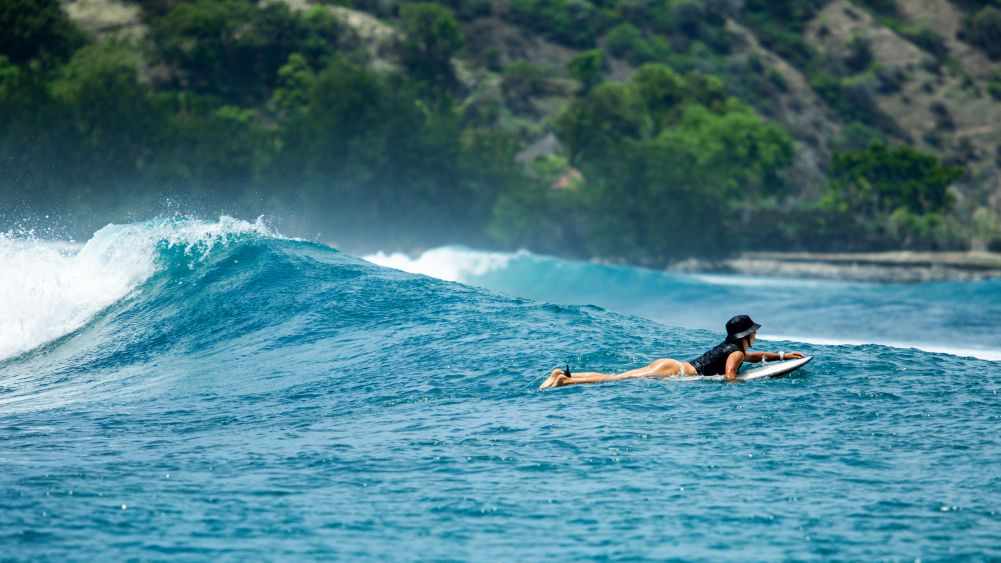
4. Bombea la tabla
Para ir más rápido sobre la ola, intenta bombear tu tabla. Esto significa mover la tabla hacia arriba y hacia abajo sobre la superficie de la ola para ganar velocidad e impulso. Bombear es una forma común y efectiva de acelerar mientras surfeas porque utiliza la energía de la ola y el esfuerzo de tu cuerpo. A continuación, te damos algunos consejos:
- Comience cerca de la parte inferior de la ola, donde tiene más velocidad.
- Sube la ola estirando las piernas y balanceando los brazos en la dirección en la que quieres girar.
- Baja por la ola doblando las piernas y balanceando los brazos en la dirección opuesta a tu giro.
- Sigue haciendo esto tanto como puedas o mientras la ola lo permita. Esto hace que tus movimientos sean más fluidos y te ayuda a ir más rápido y hacer más trucos.
Al bombear tu tabla, puedes aumentar tu velocidad y divertirte más montando la ola, además de poder hacer trucos geniales.
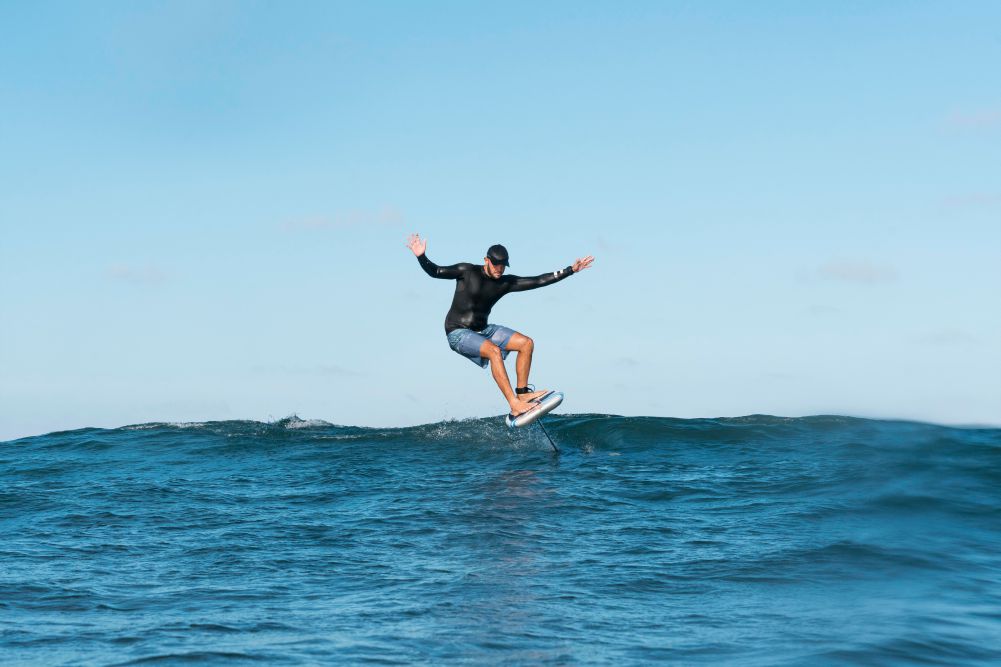
5. Recorta tu tabla
Ajustar la tabla significa ajustar la posición y el peso sobre la tabla, creando equilibrio y eficiencia. Ajustar la tabla determina qué tan bien puedes usar la tabla y la ola para generar velocidad. Requiere buena atención, sensibilidad y delicadeza. A continuación, se ofrecen algunos consejos para ajustar la tabla:
- Mueve tu peso hacia la parte delantera de tu tabla de surf. Esto te ayudará a atrapar mejor las olas y reducirá la resistencia, lo que te permitirá navegar más rápido.
- Desplazar el peso hacia la parte trasera de la tabla te ayuda a controlarla mejor, aumenta un poco la resistencia y evita que te inclines hacia adelante.
- Cuando quieras girar o hacer un truco, mueve tu peso hacia un lado de la tabla para ejercer presión sobre los bordes (rieles) de la tabla, lo que hará que sea más fácil girar.
Puedes optimizar tu velocidad y eficiencia en la ola perfeccionando tus habilidades para ajustar la tabla, mejorando en última instancia tu estilo y técnica.
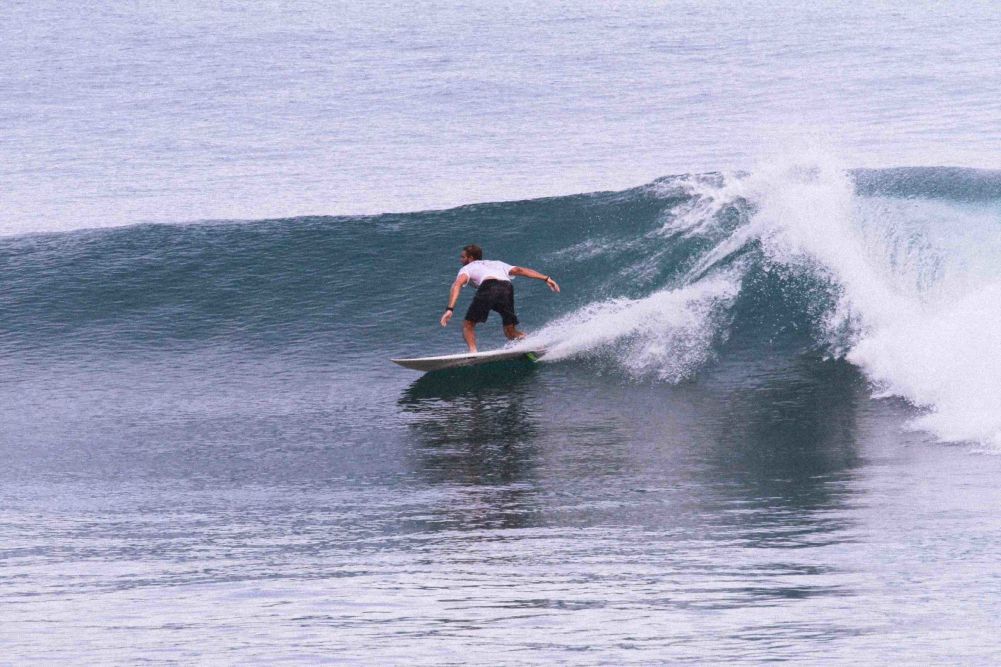
6. Mantente agachado
Mantenerse agachado significa mantener el cuerpo cerca de la tabla, lo que genera estabilidad y equilibrio. Es fundamental Cómo generar velocidad de surf Esto influye significativamente en tus habilidades en las olas.
- Baja tu postura: Dobla profundamente las rodillas para acercar el cuerpo a la tabla, mejorando la estabilidad y reduciendo la resistencia contra el agua.
- Coloca tus brazos: Mantenga los brazos cómodamente a los costados, lo que garantiza una generación de energía más efectiva y reduce el riesgo de fatiga y lesiones.
- Inclinarse y mirar: Adopte una posición inclinada hacia delante, manteniendo la mirada al frente. Esto le ayudará a acelerar más rápidamente, al tiempo que mejora su línea de visión y su eficiencia respiratoria.
Adoptar una postura baja aumenta tu velocidad y estabilidad, ayudando a prevenir caídas y desplomes.
7. Navega de riel a riel
El surf de canto a canto implica utilizar los bordes de la tabla para realizar giros potentes sobre la ola. Es un movimiento avanzado que demuestra que tienes control sobre la tabla y la ola, y es muy importante para ir rápido y moverte con facilidad.
- Riel frontal para escalar olas: Cuando subas una ola o hagas un giro superior, presiona hacia abajo la parte delantera de tu tabla. Poner más peso en el pie delantero te ayudará a ganar velocidad y a girar con más potencia.
- Riel trasero para curvas cerradas: Para bajar una ola o hacer un giro brusco, inclínate sobre la parte trasera de la tabla. Si trasladas tu peso al pie trasero, los giros serán más bruscos y rápidos.
- Rieles que cambian suavemente: Cambia suavemente entre la parte delantera y trasera de tu tabla cuando subes, bajas o cambias de dirección en una ola. Hacer esto mantiene tu navegación suave y te ayuda a ir más rápido y a girar mejor, lo que te enseña Cómo generar velocidad de surf .
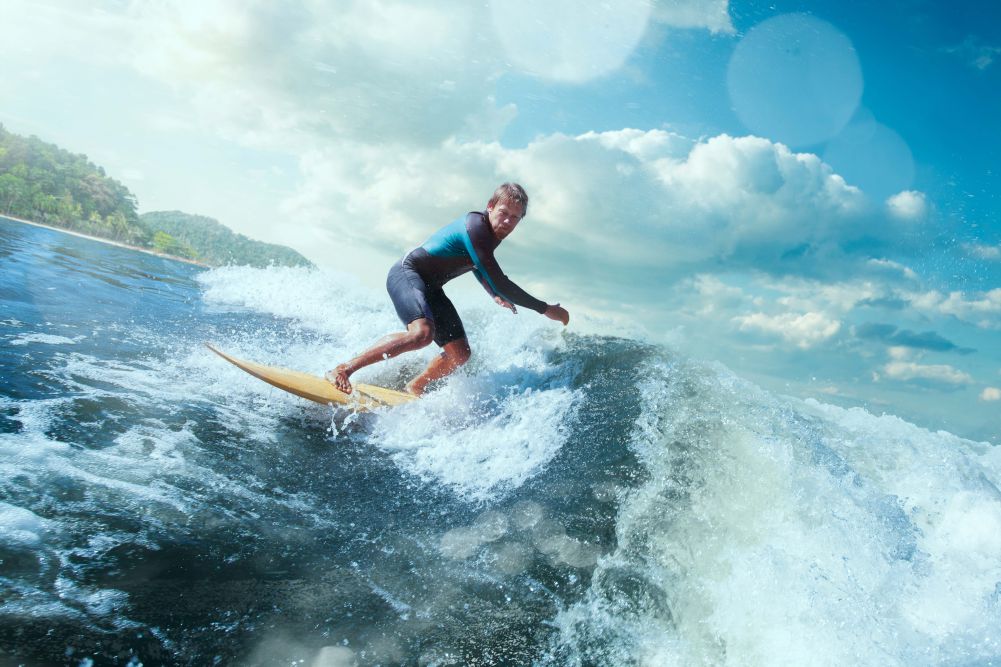
8. Evite los saltos planos
Los flat hops son pequeños saltos que algunos surfistas usan para intentar ganar velocidad en sus tablas de surf, especialmente en olas lentas o planas. Sin embargo, estos saltos no son la mejor manera de ir rápido porque pueden reducir la velocidad y hacer que tu surf sea menos suave. Tampoco se ven muy bien, ya que pueden parecer un poco torpes. Esto es lo que puedes hacer en lugar de flat hops, pero aún así debes saber Cómo generar velocidad de surf :
- Súbete a la ola, no al aire: La mejor manera de ir más rápido es utilizando la propia energía de la ola. Navega a lo largo de ella en lugar de intentar rebotar en el aire.
- Utilice más las piernas: Las piernas son fundamentales para ir rápido. Úsalas para impulsar y deslizar la tabla a lo largo de la ola en lugar de hacer que rebote hacia arriba y hacia abajo.
- Deja que tus brazos te ayuden: Usa los brazos para mantener el equilibrio y orientarte. Muévelos para guiar la tabla suavemente sobre la ola, no para intentar elevarte en el aire.
Si evitas los saltos planos y te concentras en estos consejos, surfearás más rápido y con más fluidez, ¡y tendrás mejor aspecto al hacerlo!
9. Manténgase cerca del bolsillo
El bolsillo, también llamado fuente de energía, es el mejor lugar para realizar movimientos rápidos e impresionantes en el surf. Es la parte de la ola donde la gravedad y el costado de la tabla te ayudan a ganar velocidad. Los surfistas que usan tablas más pequeñas suelen permanecer cerca del bolsillo. Si observas a alguien bueno en una tabla corta, verás que sabe dónde ir para ganar velocidad.
Lo más importante para surfear rápido es aprovechar la potencia de la ola. La parte más empinada de la ola, especialmente el tercio superior cerca del borde, tiene la mayor potencia. Ese es el bolsillo o el rizo. Es donde los profesionales obtienen su impulso y comienzan sus trucos. Saber esto es una parte importante de Cómo generar velocidad de surf .
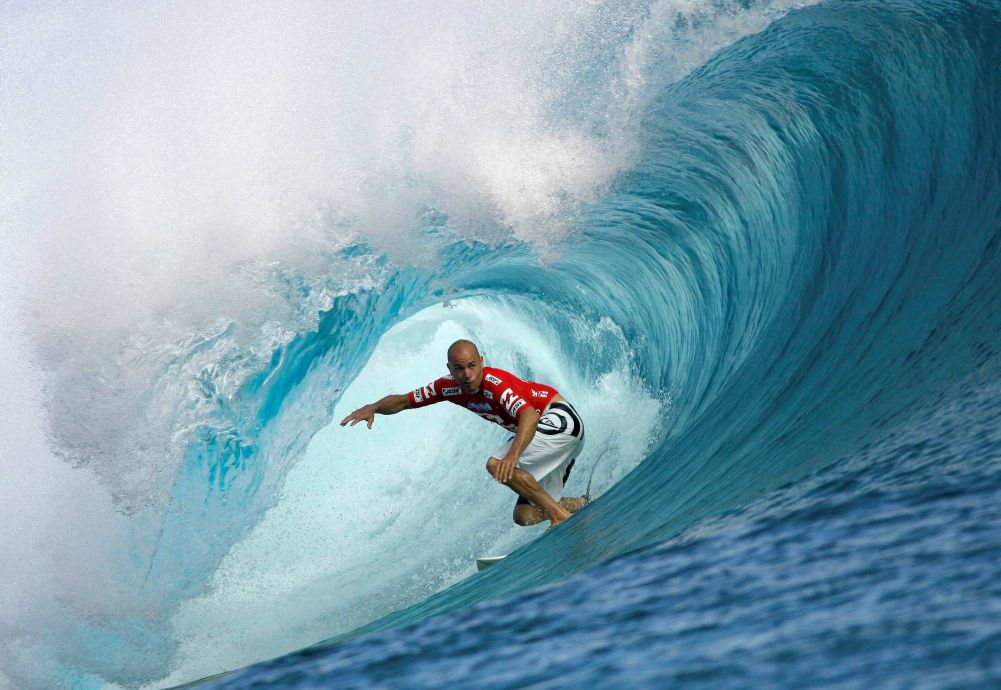
10. Mantente relajado
Para surfear bien, hay que mantener el cuerpo y la mente en calma, lo que ayuda a moverse con fluidez y mantener un buen ritmo sobre las olas. Muchos surfistas no se dan cuenta de lo importante que es la relajación para su velocidad y su buen surf.
11. Práctica
Practicar de forma regular y constante es la mejor manera de mejorar en el surf. Es una parte fundamental Cómo generar velocidad al hacer surf . Para practicar de manera efectiva, se necesita dedicación, disciplina y paciencia. A continuación, se muestra cómo practicar bien:
- Navegar con frecuencia: Cuanto más practiques surf, mejor te irá. El surf suele mejorar tus habilidades y tu estado físico, además de que te acostumbras más a diferentes olas.
- Explorar diferentes condiciones: Prueba a hacer surf en diferentes condiciones climáticas y en diferentes playas. De esta forma, ampliarás tus conocimientos, serás más adaptable y te enfrentarás a nuevos desafíos.
- Surfea con otros surfistas: Practica surf con personas que tienen diferentes habilidades. De esta manera, puedes aprender cosas nuevas de los demás y también enseñar lo que sabes, lo que es excelente para tus habilidades sociales.
Si dedicas tiempo y esfuerzo a practicar, surfearás mejor y más rápido, pero también lo disfrutarás más.
Elige Boost Fin para atrapar más olas
¿Estás listo para llevar tu surf al siguiente nivel? No busques más que la aleta Boost, un accesorio que se puede colocar fácilmente en cualquier tabla en solo 5 minutos. Estas son las razones por las que todo surfista debería considerar la aleta Boost:
- Poder impresionante: La aleta Boost cuenta con un increíble empuje de 20 libras, equivalente a la potencia de 15 remeros en una canoa.
- Aumento de velocidad: Puedes alcanzar velocidades de hasta 10 mph, lo que hace que sea más fácil y rápido atrapar esas olas perfectas.
- Mayor duración de la batería: Disfruta de sesiones de surf más largas gracias a la batería del Boost Fin, que dura entre 60 y 90 minutos con una sola carga.
Especificaciones rápidas:
- Ligero: Con un peso de solo 2,7 libras, no agregará peso significativo a tu tabla.
- Construido para durar: Fabricado con polímero reforzado con fibra de vidrio duradero y plástico ABS.
- Batería de primera calidad: Equipado con una batería de iones de litio de 3500 mAh, 24 V, 84 Wh para un uso prolongado.
- Control sin esfuerzo: Incluye un control remoto sensible de 433 MHz para facilitar su uso.
Boost Fin ofrece una forma asequible de mejorar tu tabla de surf. Si bien algunas aletas eléctricas pueden costar hasta $1000, Boost Fin tiene un precio de solo $499. Es una solución confiable, rápida y económica para que tus sesiones de surf sean más emocionantes.
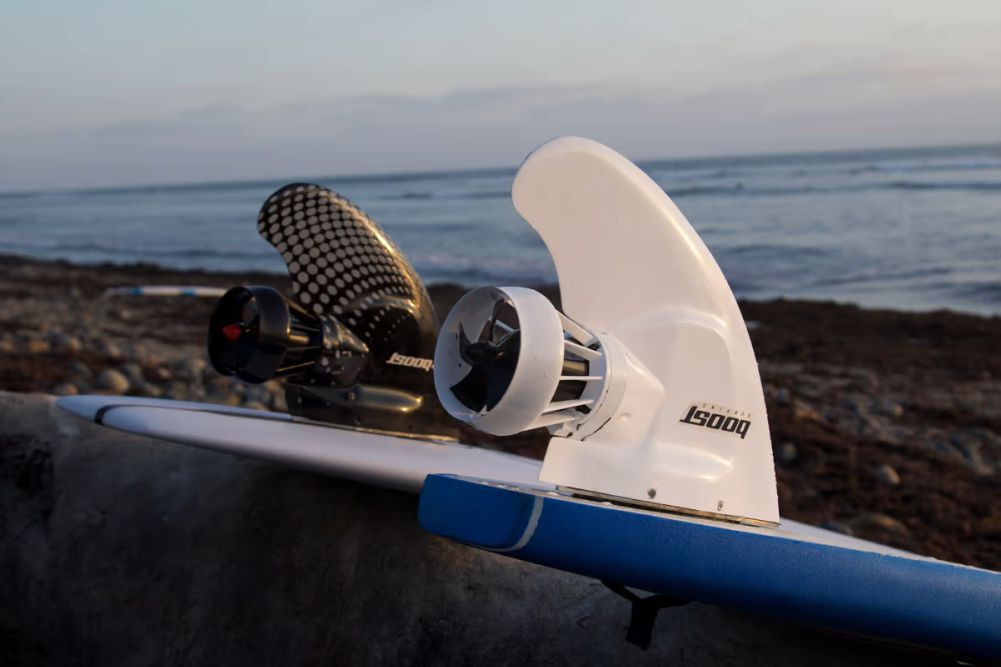
Generar velocidad al surfear con Boost Fin
La velocidad es el lema del surf: significa más olas, más trucos y más diversión. Sin embargo, para los principiantes, el arte de generar velocidad en una tabla de surf puede ser un desafío. Hemos profundizado tanto en técnicas fundamentales como avanzadas de Cómo generar velocidad de surf para ayudarte a aumentar tu velocidad de navegación. Además, te presentaremos Boost Fin , que puede potenciar tu rendimiento.
Ahora es el momento de poner en práctica estas técnicas y ver qué tan rápido puedes surfear esas olas. ¡Feliz surf!


Compartir:
Remar en el surf: cómo remar en una tabla de surf
¿Es peligroso el surf? 13 riesgos comunes del surf